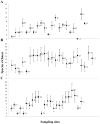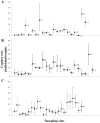Phyllostomid bat occurrence in successional stages of neotropical dry forests
- PMID: 24404175
- PMCID: PMC3880304
- DOI: 10.1371/journal.pone.0084572
Phyllostomid bat occurrence in successional stages of neotropical dry forests
Abstract
Tropical dry forests (TDFs) are highly endangered tropical ecosystems being replaced by a complex mosaic of patches of different successional stages, agricultural fields and pasturelands. In this context, it is urgent to understand how taxa playing critical ecosystem roles respond to habitat modification. Because Phyllostomid bats provide important ecosystem services (e.g. facilitate gene flow among plant populations and promote forest regeneration), in this study we aimed to identify potential patterns on their response to TDF transformation in sites representing four different successional stages (initial, early, intermediate and late) in three Neotropical regions: México, Venezuela and Brazil. We evaluated bat occurrence at the species, ensemble (abundance) and assemblage level (species richness and composition, guild composition). We also evaluated how bat occurrence was modulated by the marked seasonality of TDFs. In general, we found high seasonal and regional specificities in phyllostomid occurrence, driven by specificities at species and guild levels. For example, highest frugivore abundance occurred in the early stage of the moistest TDF, while highest nectarivore abundance occurred in the same stage of the driest TDF. The high regional specificity of phyllostomid responses could arise from: (1) the distinctive environmental conditions of each region, (2) the specific behavior and ecological requirements of the regional bat species, (3) the composition, structure and phenological patterns of plant assemblages in the different stages, and (4) the regional landscape composition and configuration. We conclude that, in tropical seasonal environments, it is imperative to perform long-term studies considering seasonal variations in environmental conditions and plant phenology, as well as the role of landscape attributes. This approach will allow us to identify potential patterns in bat responses to habitat modification, which constitute an invaluable tool for not only bat biodiversity conservation but also for the conservation of the key ecological processes they provide.
Conflict of interest statement
Figures


Similar articles
-
Local and landscape factors determining occurrence of phyllostomid bats in tropical secondary forests.PLoS One. 2012;7(4):e35228. doi: 10.1371/journal.pone.0035228. Epub 2012 Apr 18. PLoS One. 2012. PMID: 22529994 Free PMC article.
-
[Effects of landscape and vegetation structure on the diversity of phyllostomid bats (Chiroptera: Phyllostomidae) in Oaxaca, Mexico].Rev Biol Trop. 2014 Mar;62(1):217-39. Rev Biol Trop. 2014. PMID: 24912355 Spanish.
-
Season-specific and guild-specific effects of anthropogenic landscape modification on metacommunity structure of tropical bats.J Anim Ecol. 2015 Mar;84(2):373-85. doi: 10.1111/1365-2656.12299. Epub 2014 Oct 20. J Anim Ecol. 2015. PMID: 25283305
-
The role of frugivorous bats in tropical forest succession.Biol Rev Camb Philos Soc. 2007 Nov;82(4):573-90. doi: 10.1111/j.1469-185X.2007.00026.x. Biol Rev Camb Philos Soc. 2007. PMID: 17944618 Review.
-
Ecological integrity of tropical secondary forests: concepts and indicators.Biol Rev Camb Philos Soc. 2023 Apr;98(2):662-676. doi: 10.1111/brv.12924. Epub 2022 Dec 1. Biol Rev Camb Philos Soc. 2023. PMID: 36453621 Review.
Cited by
-
Season-modulated responses of Neotropical bats to forest fragmentation.Ecol Evol. 2017 May 13;7(11):4059-4071. doi: 10.1002/ece3.3005. eCollection 2017 Jun. Ecol Evol. 2017. PMID: 28616200 Free PMC article.
-
Response of phyllostomid bat diversity to tree cover types in North-western Ecuador.Sci Rep. 2024 Oct 3;14(1):22987. doi: 10.1038/s41598-024-74063-7. Sci Rep. 2024. PMID: 39363055 Free PMC article.
-
A multifaceted approach to understanding bat community response to disturbance in a seasonally dry tropical forest.Sci Rep. 2021 Mar 11;11(1):5667. doi: 10.1038/s41598-021-85066-z. Sci Rep. 2021. PMID: 33707588 Free PMC article.
References
-
- Maass JM (1995) Conversion of tropical dry forest pasture and agriculture. In: Bullock SH, Mooney HA, Medina E, editors. Seasonally dry tropical forests. Cambridge: Cambridge University Press. 399–422.
-
- Primack R, Rozzi R, Massardo F, Feinsinger P (2001) Destrucción y degradación del habitat. In: Primack R, Rozzi R, Feinsinger P, Dirzo R, Massardo F, editors. Fundamentos de conservación biológica: perspectivas latinoamericanas. D.F., Mexico: FCE. 183–223.
-
- Quesada M, Stoner KE (2004) Treats to the conservation of tropical dry forest in Costa Rica. In: Frankie GW, Mata A, Vinson SB, editors. Biodiversity conservation in Costa Rica: learning the lessons in a seasonal dry forest. Berkeley: University of California Press. 266–280.
-
- Sanchez-Azofeifa GA, Quesada M, Rodríguez JP, Nassar JM, Stoner KE, et al. (2005) Research priorities for neotropical dry forest. Biotropica 37: 477–485.
-
- Quesada M, Sanchez-Azofeifa GA, Alvarez-Añorve M, Stoner KE, Avila-Cabadilla LD, et al. (2009) Sucession and management of tropical dry forest in the Americas: review and new perspectives. For Ecol Manage 258: 1014–1024.
Publication types
MeSH terms
LinkOut - more resources
Full Text Sources
Other Literature Sources

